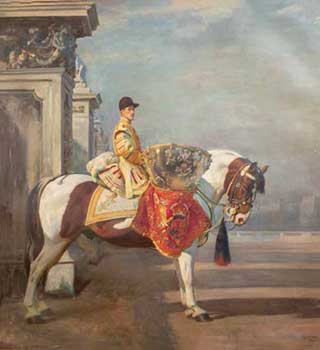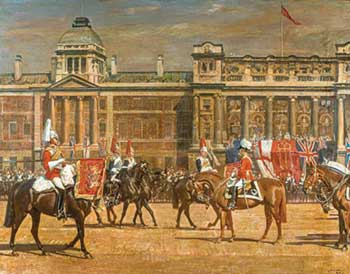|
Sir Alfred Munnings (1878-1959) A Life of his Own
|
In late April this year an exhibition of the works of Sir Alfred Munnings, presented by the British Sporting Art Trust, opened in London. The exhibition has now moved to The National Horseracing Museum, Newmarket, and closes on 12th June.
Among the many fine pictures in the exhibition are two that will be well known to Household Cavalrymen: The Drummer of His Majesty’s First Life Guards (1922) and Presentation of the Standards to the Household Cavalry by King George V (1927). Here is an edited extract from the catalogue that accompanies the exhibition:
Sir Alfred Munnings’ brilliance as a horse painter and his perfectionist eye for detail made him an excellent choice to depict cavalry regiments in the British Army. Lieutenant Colonel Sir George Holford of the 1st Life Guards commissioned Munnings to paint a monumental canvas of drum horse Paddy in 1922. He had presented Paddy to the Regiment and wanted to commemorate the event on canvas. The painting was a tremendous success when exhibited at the Royal Academy that year and remains a well-loved painting in the collection of the Household Cavalry Mounted Regiment. The present picture was commissioned as a gift to the mess from a departing officer and Munnings worked on it intermittently for two years.
Munnings wrote ‘All the help I desired was given’ and did not hesitate to make some substantial demands. He attended a full rehearsal on Horse Guards parade and asked for the Admiralty to be dressed with flags as it would on the day itself. The artist sat in a taxi with the back open for two hours making studies that were used for the finished picture. Much of the preparatory work was done at Albany Barracks near Regent’s Park, then in use by the Royal Horse Guards.

The Drummer of His Majesty’s First Life Guards. 1922.
A J Munnings. The Drummer was George Carter, who joined the 1st Life Guards Band in and served until 1927
|
The artist wrote: ‘What an école des beaux arts I could have made of that great yard! But I forgot all the awkward moments, the rain, the wind raising the dust as it whirled round the square; recruits and their morning drill; the staccato shouts of the sergeant. “Stand – at – EASE!! March!! – Shun!!” Bawled out in true style. After all this labour there was a picture to be made. The scene, the Presentation. For two years I worked on it, leaving it for long periods. It was hung in the Academy in 1930, where it balanced my picture of Princess Mary, Lord Lascelles and the Bramham Moor hounds’.
A later commission for Alfred Munnings was The Presentation of Standards on Horse Guards. On Saturday 25th June 1927 King George V recorded in his diary: ‘At 11 O [clock] I presented new Standards to the two Household Cavalry Regiments on the Horse Guards Parade. I wore FM’s [Field Marshall’s] uniform with jack boots and we rode down the Mall. After the standards were given the regiment marched past at the walk and at the trot and it was a very fine sight…’
 Presentation of the Standards to the Household Cavalry Presentation of the Standards to the Household Cavalry
by King George V, June 1927. A J Munnings
|
Some twenty years later Munnings met the figure who posed for him on the cavalry black on the left side of the picture. He was visiting his great friend Sir Winston Churchill at Chartwell to help him select two works to be sent to the Royal Academy summer exhibition in 1949, the year the statesman was elected a member in extraordinary. ‘A tall butler opened the door: You won’t remember me, Sir Alfred, said he. I looked at him; memory failed me, and no wonder. I was the Corporal of Horse who posed for you in your Chelsea studio and sat on a horse in the square at Albany Street Barracks when you were painting the picture of King George giving the new Standards to the Household Cavalry. Captain Speed picked me out for you as a model. To think, said I, that you, in this get-up, were once the Life Guardsman, in plume helmet and breastplate and all the rest of it, sitting on a black horse for me. Yes, sir, said he, and do you remember, when you opened the door to me at Chelsea and I walked in, the plume of my helmet hit against the top of the door and gave us both a shock?’
In 1964 Presentation of the Standards was stolen from Combermere Barracks in Windsor, and subsequently a captain serving in The Life Guards was charged with its theft. 16 days later, a Household Cavalry officer saw the painting for sale in the window of St James’s Galleries, Bond Street. He telephoned the Commanding Officer and the picture was returned to the Regiment.
|
|


